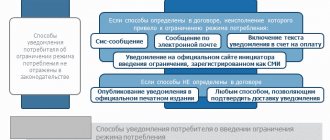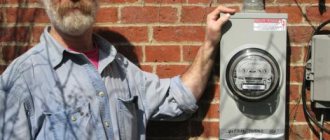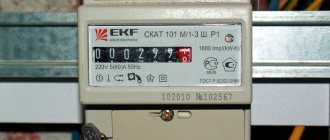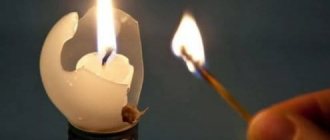Basis for determining standards
The assignment of electricity consumption standards is carried out in accordance with the provisions of the following legislative acts (the file will open in a new tab):
- Government Decree No. 614, adopted in July 2017 and defining the rules of social norms for electrical energy. Read more.
- Law No. 35-FZ, adopted in March 2003 with amendments made in 2020 and regulating general issues of electricity supply. Read more.
- Law No. 261-FZ, approved in November 2009 and designed to reduce losses in the energy supply process and promote the introduction of energy-saving technologies. Read more.
Relatively recent adjustments were made in 2013, after which the standards remained unchanged until 2020. As a result of those amendments, the values increased by 10 percent compared to what existed before.
These measures are designed to encourage consumers to install individual metering devices.
What influences the size of the standard
Due to the payment rules, it is preferable for the consumer to install a meter to determine the payment amount. In this case, the bill size will be significantly lower than when calculating according to the norms.
But sometimes the unsatisfactory condition of energy supply systems or the reluctance of the owner prevents the installation of an individual meter. In this case, there is no other choice but to set the payment amount by calculating according to the standards.
The standard indicator is determined by the following factors:
- residential and non-residential area in the apartment;
- the number of residents registered in a given living space;
- finding housing in the private sector or apartment building;
- the presence of an electric stove for cooking;
- way of organizing heating;
- whether the object belongs to an urban or rural area.
The standards are calculated empirically, after analyzing the results of actual measurements of indicators for several consumers in different regions of the country and divided into several groups.
Electricity consumption standards in some regions
The calculation methodology has been developed for the entire country, but local authorities have the right to determine the indicated indicators for their region, taking into account the influence of the region’s characteristics on the cost of electricity generation and delivery. But the deviation from the national value should not exceed 40 percent.
The maximum values of the standards established in the Russian Federation for housing equipped with an electric or gas stove (in kWh) are:
- single people with a one-room apartment - from 108 to 263, or from 81 to 185;
- families (for each resident), under appropriate conditions - in the range of 37 - 89 or 28 - 63.
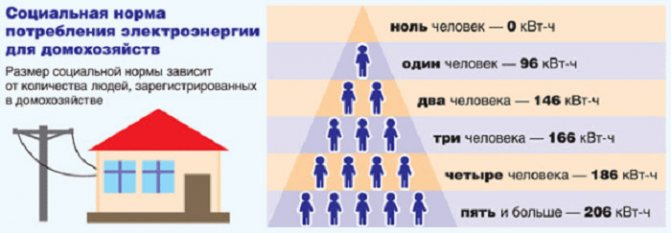
When calculating standards, the following additional factors are taken into account:
- for those living in rural areas, the value increases by 90 kWh, since energy may be required in the household;
- for pensioners living without other relatives, in the absence of a meter for a good reason, the calculation is carried out according to the social norm established by the minimum consumption value;
- If a meter is not installed at the dacha, if there are appropriate grounds, regardless of the size of the family, the calculation is carried out according to the norms for one person.
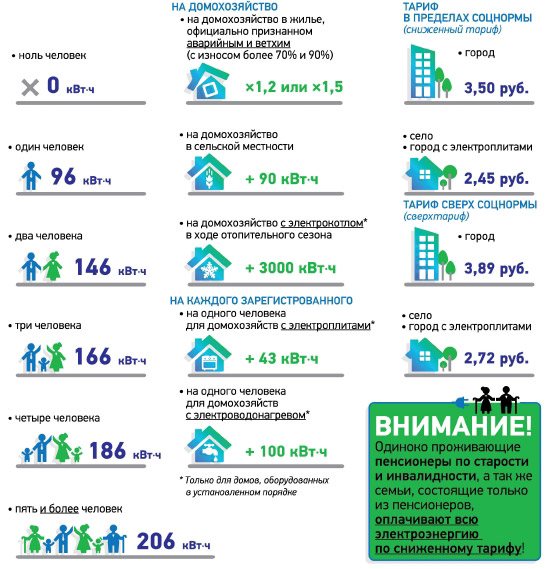
More information about the size of the established standards can be found in the decrees of local authorities.
How much electricity does a kettle consume?
An electric kettle is a convenient household appliance that can provide its owners with boiling water in a matter of minutes.
It is necessary to calculate how many kilowatts a kettle consumes, taking into account the power of the device and the maximum volume of liquid that it can bring to a boil. The larger the displacement of the device, the more time it will take to heat the water, and accordingly the amount of electricity consumed increases. On the other hand, the high power of the kettle contributes to its fast operation. However, it requires a sufficient amount of electricity.

All electric kettles are different in their parameters and, accordingly, in their level of energy consumption.
To calculate how much a kettle consumes, you should perform the following calculations:
- The power of the device is taken from the passport;
- the time it takes to boil water in the kettle is calculated;
- electricity consumption per unit time is determined;
- the resulting value should be multiplied by the number of times the water is boiled;
- monthly electricity consumption is determined.
Based on the table, the power of the electrical appliance is in the range of 700-3000 W, which depends on the volume of the bowl, body material, displacement, type of heating element, and chemical composition of the water. The heating element can be open (spiral) or closed (plate) type. The first option provides a high rate of water heating and, accordingly, uses less energy.
The energy consumption of the device is also influenced by the housing material. In a metal bowl, water heats up faster. However, an additional amount of electricity is spent on heating the case. Glass also heats up quickly, but retains heat less well. Ceramic has a slow heating rate, but the water in the kettle will remain hot for a long time.
Note! Boiling water in an electric kettle is less expensive than using an electric stove.

If you pour a minimum amount of water into the kettle without reserve, you can reduce the waste of both water and electricity.
To reduce the kettle's energy consumption, unplug the appliance from the outlet when not in use. The required volume of water should be poured into it, without reserve. You should monitor the condition of the heating element by regularly descaling it.
Calculation method
When calculating payment for consumed resources without a meter, the following formula is used:
C = K x L x Ts,
wherein
- C – total payment amount;
- K – number of people living in the living space;
- L – indicator of the limit approved in the region;
- Ts is the size of the tariff rate for one kWh, in accordance with the regulations of local authorities.
The use of an additional increasing factor is provided. Its introduction is intended to encourage citizens to install meters. The increasing factor is not used only in a situation where the installation of an individual meter is not possible due to the disrepair of the housing or the poor condition of the electrical networks.
When you have to pay taking into account the standards if you have an electric meter
In some situations, consumers have to pay according to standards even if they have an electric meter. This is necessary if:
- the metering device is out of order;
- the owner of the premises did not report indicator data to the utility company;
- access to the metering device is not provided to an employee of the energy supply company;
- the meter was damaged intentionally.
If the consumer does not provide the management company with information regarding the meter readings, the amount for the next quarter is calculated based on the average value. After the specified period, if the situation has not changed, payment is calculated according to the norms.
The breakdown of the electric meter must be confirmed by a corresponding report drawn up based on the results of an inspection of the device by a representative of the utility company. The owner must immediately report problems with the operation of the device orally (in person or by telephone) or in writing in order to record the fact of the breakdown.
Important! The electric meter can only be used within the verification period. If the verification is overdue, the meter readings are invalid.
The owner is obliged to monitor the condition of the electric meter and promptly provide the device for verification to specialized organizations that have the appropriate license.
In what cases is payment prescribed according to the standard when an electric meter is installed?
In some situations, consumers who pay for electricity according to individual meter readings may be subject to payment according to standards. This is possible if:
- there is a malfunction of the electric meter;
- the consumer does not report meter readings to the energy supply company;
- representatives of the controlling organization are not provided with regulated access to the meter;
- The device was disabled intentionally.
We recommend: Storage period for receipts for payment for residential complex services
If the consumer does not report data on actual electricity readings, according to current legislative norms, within three months the amount of payment is determined based on the average indicators for the previous six months. Starting from the fourth month, an invoice is presented at standard prices obtained by calculation, based on the tariffs and standards approved in the region.

Some tariff standards per person for regions of the Russian Federation
Cases of failure of the electric meter must be confirmed by a corresponding report drawn up by representatives of energy supervision, indicating the reasons for the failure.
Note! Metering devices can be used only until the expiration of the scheduled verification, without which the use of the electric meter is not permitted.
The consumer must control the planned verification period by ensuring access for representatives of the controlling organization to dismantle the device for the purpose of verification work.
Social norms
In order to support socially unprotected segments of the population, the state has adopted restrictions establishing the permitted limit, within which energy is paid at a preferential price.
The limit is set at 300 kWh. Up to the specified value, the price of electricity is significantly lower than in the case of excess. In addition to payment benefits, this measure is aimed at saving resources, since the consumer is interested in reducing costs in order to reduce the payment amount.
Ways to save energy resources
The use of meters allows the consumer to influence the amount of payment, reducing energy consumption. This can be achieved in the following ways:
- the acquisition of economical equipment - the international classification provides for the indication in the marking of Latin letters from A to G, in which A corresponds to the most economical devices;
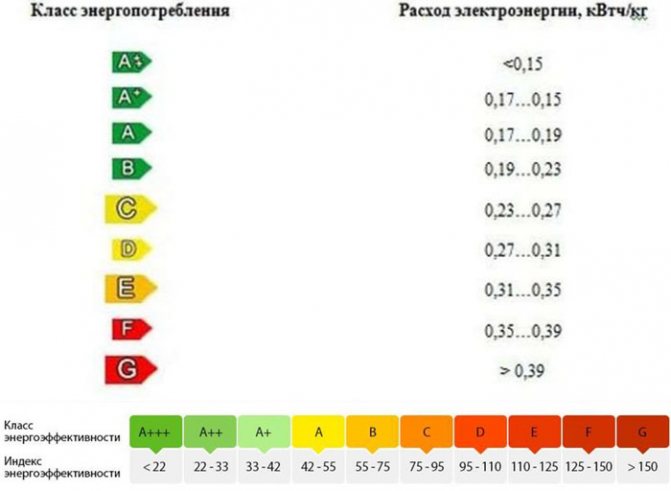
- reliable insulation of the room when the air conditioner or electric heating devices are turned on;
- timely cleaning of the internal walls of the kettle from scale, which reduces heating time;
- operation of household equipment in accordance with the manufacturer’s requirements specified in the passport;
- purchasing lamps with economical consumption characteristics.
The comprehensive implementation of these measures will significantly reduce resource consumption, reducing the electricity bill.
Guaranteed reduction in electricity bills - installation of an electric meter. This will allow the consumer to pay only for the resources actually used and eliminate the use of a multiplying factor.
Calculation of electrical power consumption at home
Material Information
51756
The main indicator calculated in a private home electrical project is the total power consumption. Having ordered an electrical project, the owner of a private house will definitely receive a power consumption figure that will be indicated in it. But it is often useful to understand the estimated power consumption even before ordering a project, at the “kilowatt” purchasing stage. A preliminary calculation will help you decide on the amount of power to purchase (if there are various offers), as well as intelligently approach your needs in terms of energy consumption. Sometimes it is more profitable to abandon some energy consumers than to pay for extra kilowatts.
The basis for calculating the total power consumption of a private home, performed during the electrical design, is the load of the final consumers of electricity. It is the data on the approximate electricity consumption of lighting elements, power equipment and household appliances used in your home that will make it possible to independently “estimate” the required kilowatts.
To independently calculate the required electrical power for your home, we provide the table “List of Electricity Consumers (approximate)” (Table No. 1). The data presented in the table is based on our experience in designing power supply and lighting systems for private homes. Being approximate, the given values of power consumption quite accurately reflect their real values, since they are taken from the technical data sheets for the corresponding equipment.
Table 1. List of electricity consumers (indicative)
| Name of equipment | pH, kW (per unit) | Un, Online |
| Incandescent lamp | 0,04…0,10 | 220 |
| Fluorescent lamp | 0,04 | 220 |
| LED lamp with high energy | 0,02 | 220 |
| Halogen lamp | 0,04 | 220 |
| Socket place | 0,1 | 220 |
| Fridge | 0,5 | 220 |
| Electric stove | 4 | 220 |
| Kitchen hood | 0,3 | 220 |
| Dishwasher | 1,5 | 220 |
| Waste shredder | 0,4 | 220 |
| Electric ignition of the stove | 0,1 | 220 |
| Air fryer | 1,2 | 220 |
| Kettle | 2,3 | 220 |
| Coffee machine | 2,0 | 220 |
| Washing machine | 1,5 | 220 |
| Oven | 1,2 | 220 |
| Dishwasher | 1,2 | 220 |
| Microwave | 1,3 | 220 |
| Hydromassage bath | 0,6 | 220 |
| Sauna | 6,0 | 380 |
| Electric boiler | 6-24 | 380 |
| Gas boiler | 0,2 | 220 |
| Boiler room pumping equipment | 0,8 | 220 |
| Chemical water treatment system | 0,2 | 220 |
| Gate drive | 0,4 | 220 |
| TV "Plasma" | 0,4 | 220 |
| Street lighting | 1,0 | 220 |
| Computer place | 0,9 | 220 |
| Electric heated floor | 0,1-1,2 | 220 |
| Septic tank | 0,3-1,0 | 220 |
| Sewage pressure station | 0,3-2,5 | 220-380 |
| Air conditioner | 1,5 | 220 |
| Ventilation unit | 0,3-7,4 | 220-380 |
| Sauna | 3,8-14 | 220-380 |
| Electric fireplace | 0,3 | 220 |
| Seeing off roller shutters | 0,3 | 220 |
| Electric heated towel rails | 0,3-1,2 | 220 |
| Steam generator | 2,0-7,0 | 380 |
| Borehole pump | 0,8-5,0 | 220-380 |
In addition to the data given in Table 1, the calculation will also require a demand coefficient, the value of which is clearly defined by regulatory documents and is shown in Table No. 2.
Table 2. Demand factors (according to standards)
┌────────────────────┬─────┬─────┬──────┬─────┬─────┬─────┬─────────────┐
│Declared power,│up to 14│ 20 │ 30 │ 40 │ 50 │ 60 │ 70 and more │
│ kW │ │ │ │ │ │ │ │
├────────────────────┼─────┼─────┼──────┼─────┼─────┼─────┼─────────────┤
│Demand coefficient │ 0.8 │0.65 │ 0.6 │0.55 │ 0.5 │0.48 │ 0.45 │
└────────────────────┴─────┴─────┴──────┴─────┴─────┴─────┴─────────────┘
Example : if the sum of consumers is 32.8 kW, then according to table No. 1 the demand coefficient will be equal to 0.6. Multiplying 32.8 kW by 0.6, we get an approximate value of power consumption (per house) of 19.68 kW.
You can later use the resulting estimate of the power consumption of your home to adjust the value of the purchased power, or your needs, if the allocated power is less than the obtained value.

